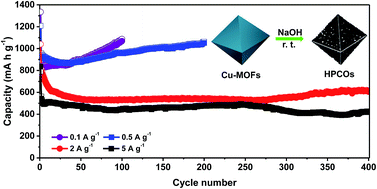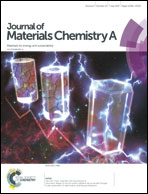Hierarchical CuO octahedra inherited from copper metal–organic frameworks: high-rate and high-capacity lithium-ion storage materials stimulated by pseudocapacitance†
Abstract
The controllable synthesis and tailoring of the structure of metal oxide electrodes to achieve high rate capability and stability still remain formidable challenges. In this paper, a room-temperature solid–solid transformation route was introduced for the fabrication of a hierarchically structured porous CuO octahedron (HPCO) electrode by treating a copper metal–organic framework template, namely, Cu-BTC, with an alkaline solution. The HPCOs substantially inherited the morphology and size of the precursor Cu-BTC and were constructed by the assembly of many ultrathin nanosheets with average lateral sizes of ca. 250 nm. When acting as a host for the storage of Li+ ions, the as-fabricated HPCO electrode exhibited unprecedented performance that benefited from its advantageous structural features, with an ultrahigh capacity of 1201 mA h g−1 and superb high-rate performance with excellent cycling stability (1062, 615, and 423 mA h g−1 at 0.5, 2, and 5 A g−1, after 200, 400, and 400 repeated cycles, respectively). It is noteworthy that a surface redox pseudocapacitive effect contributed significantly to the high capacity and high rate of Li-ion storage of the HPCO electrode. This encouraging result may accelerate the further development of LIBs by a smart strategy for the micro/nanoengineering of metal oxide-based electrode materials.



 Please wait while we load your content...
Please wait while we load your content...